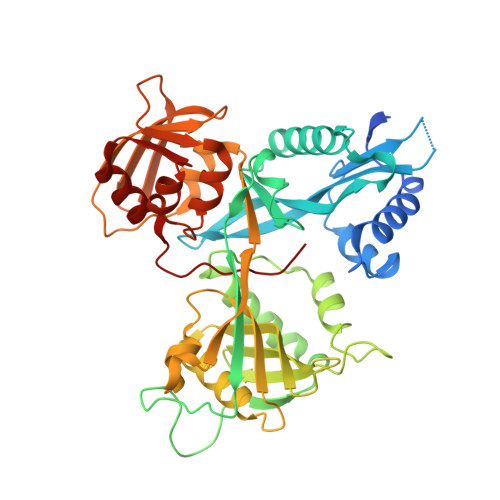Structure-Guided Optimization of Inhibitors of Acetyltransferase Eis fromMycobacterium tuberculosis.
Punetha, A., Ngo, H.X., Holbrook, S.Y.L., Green, K.D., Willby, M.J., Bonnett, S.A., Krieger, K., Dennis, E.K., Posey, J.E., Parish, T., Tsodikov, O.V., Garneau-Tsodikova, S.(2020) ACS Chem Biol 15: 1581-1594
- PubMed: 32421305
- DOI: https://doi.org/10.1021/acschembio.0c00184
- Primary Citation of Related Structures:
6VUR, 6VUS, 6VUT, 6VUU, 6VUW, 6VUX, 6VUY, 6VUZ, 6VV0, 6VV1, 6VV2, 6VV3 - PubMed Abstract:
The enhanced intracellular survival (Eis) protein of Mycobacterium tuberculosis ( Mtb ) is a versatile acetyltransferase that multiacetylates aminoglycoside antibiotics abolishing their binding to the bacterial ribosome. When overexpressed as a result of promoter mutations, Eis causes drug resistance. In an attempt to overcome the Eis-mediated kanamycin resistance of Mtb , we designed and optimized structurally unique thieno[2,3- d ]pyrimidine Eis inhibitors toward effective kanamycin adjuvant combination therapy. We obtained 12 crystal structures of enzyme-inhibitor complexes, which guided our rational structure-based design of 72 thieno[2,3- d ]pyrimidine analogues divided into three families. We evaluated the potency of these inhibitors in vitro as well as their ability to restore the activity of kanamycin in a resistant strain of Mtb , in which Eis was upregulated. Furthermore, we evaluated the metabolic stability of 11 compounds in vitro . This study showcases how structural information can guide Eis inhibitor design.
Organizational Affiliation:
Department of Pharmaceutical Sciences, University of Kentucky, Lexington, Kentucky 40536-0596, United States.


















